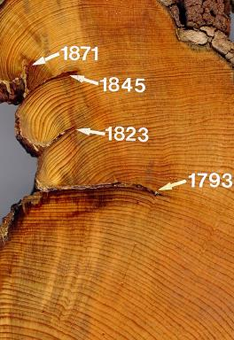NOAA/WDS Paleoclimatology - Heyerdahl fire data from Potholes, central Oregon - IMPD USPOT002
This archived Paleoclimatology Study is available from the NOAA National Centers for Environmental Information (NCEI), under the World Data Service (WDS) for Paleoclimatology. The associated NCEI study type is Fire. The data include parameters of fire history with a geographic location of Oregon, United States Of America. The time period coverage is from 460 to -59 in calendar years before present (BP). See metadata information for parameter and study location details. Please cite this study when using the data.
- Cite as: Heyerdahl, E.K.; Falk, D.A.; Loehman, R.A. (2015-02-25): NOAA/WDS Paleoclimatology - Heyerdahl fire data from Potholes, central Oregon - IMPD USPOT002. [indicate subset used]. NOAA National Centers for Environmental Information. https://doi.org/10.25921/8gq6-hb15. Accessed [date].
- Please refer to Credit tab for full citation information.
- doi:10.25921/8gq6-hb15
- noaa-fire-18097
- NCEI DSI 1200_02
- NCEI DSI 1200_01
noaa-fire-18097
| Search Data |
|
| Download Data |
|
| Distribution Formats |
|
| Ordering Instructions | Contact NCEI for other distribution options and instructions. |
| Distributor | NOAA National Centers for Environmental Information
ncei.info@noaa.gov |
| Dataset Point of Contact | NOAA National Centers for Environmental Information
ncei.info@noaa.gov |
| Dataset Point of Contact | Data Center Contact
NOAA World Data Service for Paleoclimatology 828-271-4800 paleo@noaa.gov |
| Coverage Description | Date Range: 1490 CE to 2009 CE; Date Range: 460 cal yr BP to -59 cal yr BP; |
| Time Period | 1490 to 2009 |
| Spatial Bounding Box Coordinates |
N: 43.730972
S: 43.730972
E: -120.942639
W: -120.942639
|
| Spatial Coverage Map | |
| General Documentation |
|
| Associated Resources |
|
| Publication Dates |
|
| Data Presentation Form | Digital table - digital representation of facts or figures systematically displayed, especially in columns
|
| Dataset Progress Status | Complete - production of the data has been completed |
| Data Update Frequency | Data update frequency not available |
| Supplemental Information |
STUDY NOTES: This site was sampled as part of a project to reconstruct historical fire regimes in central Oregon. Ring-boundary fire scars were assigned to the preceding calendar year. Several metadata files are provided with the FHX file. -999 in any file indicates no data. Ring-boundary fire scars were assigned to the preceding calendar year. Several metadata files are provided with the FHX file. -999 in any file indicates no data. Four supplemental information files are located at URL - http://www.ncei.noaa.gov/pub/data/paleo/firehistory/firescar/northamerica/supplemental/ : (1) uspot002-plot-data.csv provides information on the plots. (2) uspot002-saplings.csv provides information on small trees that we did not attempt to remove wood samples from. These trees were tallied in each plot by species and diameter class (measured at breast height, 1.4 m) in 5.6-m radius plots. Diameter classes: 2.5 (0-5 cm), 7.5 (5-10 cm), 15 (10-20 cm). (3) uspot002-scarred-tree-info.csv provides information on fire-scarred trees, including ones we also sampled for recruitment date. (4) uspot002-undatable-trees.csv provides information on trees from which it did not appear that we could obtain intact wood samples.
ABSTRACT SUPPLIED BY ORIGINATOR: In parts of central Oregon, coarse-textured pumice substrates limit forest composition to low-density lodgepole pine (Pinus contorta Douglas ex Loudon var. latifolia Engelm. ex S. Watson) with scattered ponderosa pine (Pinus ponderosa Lawson & C. Lawson) and a shrub understory dominated by antelope bitterbrush (Purshia tridentata (Pursh) DC.). We reconstructed the historical fire regime from tree rings and simulated fire behavior over 783 hectares of this forest type. For centuries (1650-1900), extensive mixed-severity fires occurred every 26 to 82 years, creating a multi-aged forest and shrub mosaic. Simulation modeling suggests that the historical mix of surface and passive crown fire were primarily driven by shrub biomass and wind speed. However, a century of fire exclusion has reduced the potential for the high-severity patches of fire that were common historically, likely by reducing bitterbrush cover, the primary ladder fuel. This reduced shrub cover is likely to persist until fire or insects create new canopy gaps. Crown fire potential may increase even with current fuel loadings if the climate predicted for mid-century lowers fuel moistures, but only under rare extreme winds. This study expands our emerging understanding of complexity in the disturbance dynamics of lodgepole pine across its broad North American range. |
| Purpose | Records of past fire occurrence from tree rings, charcoal found in lake sediments, and other proxies. Parameter keywords describe what was measured in this dataset. Additional summary information can be found in the abstracts of papers listed in the dataset citations. Additional information on the International Multiproxy Database (IMPD) dataset procedures are also available. |
| Dataset Citation |
|
| Cited Authors |
|
| Originators |
|
| Publishers |
|
| Theme keywords | Global Change Master Directory (GCMD) Science Keywords
|
| Data Center keywords | Global Change Master Directory (GCMD) Data Center Keywords
|
| Place keywords |
|
| Use Constraints |
|
| Access Constraints |
|
| Fees |
|
Last Modified: 2023-10-11
For questions about the information on this page, please email: ncei.info@noaa.gov
